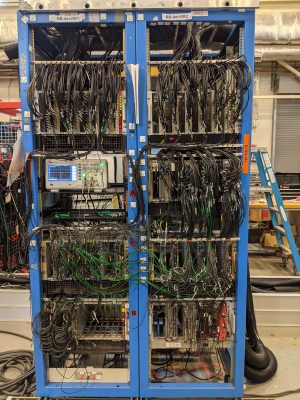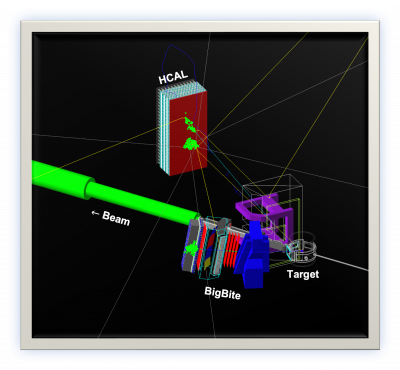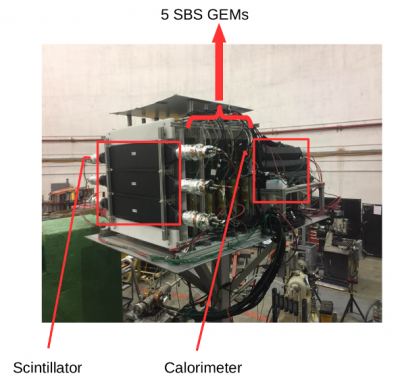Testing, Commissioning, & Calibration of the BigBite Calorimeter (BBCAL) | 2021 – Current
description forthcoming..
Commissioning of BigBite Trigger | 2021
description forthcoming..

HV logging | 2021
Goal: Set up the High Voltage (HV) logging machinery for all the SBS detector sub-systems.
Description: It was a short and very interesting side project. Keeping track of the HVs of all the detector channels is a crucial part of the experiment. Significant fluctuations of the HVs during a run can cause severe issues. All the detector HV channels are made EPICS variables, so that we can read, change, and keep record of their values remotely. My job was to write scripts to track those EPICS variables in real time for the purpose of logging their values at the beginning of every run. I learned Pearl, a scripting language, during this project.
Resources: The entire machinery has been kept in a stand alone git repository, HV_logging_SBS, along with well developed README file.
Photon-Neutron Separation in HCAL for GEn-II | 2020 – 2021
Goal: Demonstration of sufficient neutron-photon separation in hadron calorimeter (HCAL) for highest Q^2 point of SBS-GEn-II experiment where neutrons travel nearly at the speed of light.
Description: This project was started to prepare a response for one of the charges of SBS-GEn-II ERR (Experimental Readiness Review). Using the difference in ToF between neutron and photon for this purpose wasn't an option, since the neutrons at that Q^2 travels nearly at the speed of light. So, we aimed to find another way of distinction by looking at their pulse shapes. The project was very involved and required a lot of preparations. We started by modifying the inelastic generator in g4sbs (GENT4 simulation framework for SBS experiments) so that it generates the final state nucleons as well as the pions. Full optical simulations were needed to be able to track all the photons generated via hadronic shower due to neutron and also via electromagnetic shower due to photons. Study revealed that photons deposit most of their energy near the front of HCAL modules whereas neutrons penetrate much deeper - which should introduce distinguishable differences in their respective pulse shapes. In order to investigate such a difference in the pulse shape we had to add mechanism to store pulse shape information to g4sbs. The last step was to digitize the pulses using the pulse shape information.
Conclusion: We found that the digitized pulses due to neutron and photon indeed have distinguishable shapes but unfortunately that distinguishing feature gets wiped out by either the front end electronics or the PMT response itself. A further in-depth study is needed to move forward. Linked slides contain a summary of the entire project.
Trigger Rate Estimation for GMn and GEn-RP | 2020
Goal: Estimation of the single arm BigBite trigger rates for SBS-GMn and -GEn-RP experiments via simulation for experimental readiness.
Description: SBS-GMn had the largest installation of Gas Electron Multipliers (GEMs) in the USA till date. There are 5 GEM layers in the electron arm - each layer has an active area of approx. 50x180 cm^2. Due to very high luminosity GEM raw rate is ~ 100 kHz/cm^2! Such a huge data rate makes data acquisition (DAQ) and reconstruction very challenging. So, it was crucial to have an estimate of the GEM occupancy via simulation well before the experiment started for the purpose of preparation. Along with single arm BigBite trigger rates we also estimated the single arm hadron calorimeter (HCAL) trigger rates to assess the possibility of coincidence trigger between BigBite and HCAL to keep the DAQ rate manageable.
Conclusion: Single arm trigger rate for GMn seemed manageable but the for GEn-RP we must use coincidence. We wrote a detailed report on this study describing each and every step in details.

Add Shielding to SBS Dipole Yoke in SBS-GEnRP GEANT4 Setup | 2020
Goal: Plugging the gap in the SBS dipole in SBS-GEnRP GEANT4 setup to evaluate its usefulness in keeping SBS side hodoscope rates manageable, via simulation.
Description: This was another very short but fun GEANT4 project. As the title suggests, the main work was to design a Pd box that matches the dimension of SBS dipole yoke exactly. We had be flexible with the motion of SBS arm. Hence, we defined the variables, which construct the dimension of the shielding, in such a way so that whenever we move SBS dipole the shielding also moves along with it properly.
Conclusion: The outcome of the simulations confirmed that the above mentioned shielding is indeed necessary to keep the SBS side hodoscope rates manageable. Attached pictures should provide some insight into the design.

Hall A GEM Study | 2020
Goal: Investigate the reason behind poor Gas Electron Multiplier (GEM) position resolution encountered during Hall A beam test of GEMs in 2016.
Description: This was my first simulation project after joining Prof. Puckett's group. The journey to learn ROOT and GEANT4 began with this project. We started by implementing the Hall A GEM test setup in g4sbs (GENT4 simulation framework for SBS experiments). Threw a few low energy electrons at the GEMs and could regenerate the spatial resolution we saw from real data.
Conclusion: We concluded that the apparent poor spatial resolution of GEMs were largely attributable to multiple scattering of low energy electrons. I made a presentation summarizing the study.
